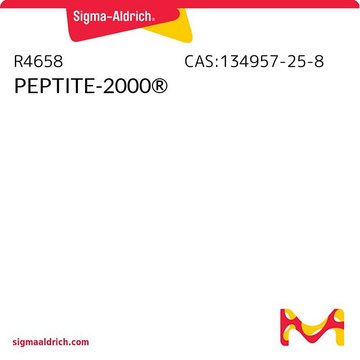Wichtige Dokumente
R8755
RPMI-1640-Medium
With ʟ-glutamine, without phenol red and sodium bicarbonate, powder, suitable for cell culture
Synonym(e):
Roswell Park Memorial Institute 1640 medium
About This Item
Empfohlene Produkte
product name
RPMI-1640-Medium, Modified, with L-glutamine, without phenol red and sodium bicarbonate, powder, suitable for cell culture
Form
powder
Methode(n)
cell culture | mammalian: suitable
Komponenten
HEPES: no
phenol red: no
L-glutamine: yes
NaHCO3: no
sodium pyruvate: no
Versandbedingung
ambient
Lagertemp.
2-8°C
Suchen Sie nach ähnlichen Produkten? Aufrufen Leitfaden zum Produktvergleich
Allgemeine Beschreibung
Anwendung
- Es wird in Zellkulturmedium eingesetzt: Murine EL-4-Thymomzellen wurden in RPMI-1640-Medium mit anderen Komponenten ergänzt
- Es wird zur mykobakteriellen Infektion von Splenozyten eingesetzt (in antibiotikafreiem RPMI-1640-Medium)
- Es wird zur Isolation und Kultivierung von Zellen eingesetzt
- Es wird als Kulturmedium (als eine der Komponenten) während der Lymphozytentrennung und -kultivierung, ELISPOT-Assay, Ex-vivo-Proliferationsassay eingesetzt
- Es wird in Medium für die gp39-Genexpression und CD40-Immunglobulinbindungsassays eingesetzt
- Es wird zur Herstellung von Antimykotika eingesetzt
Menge
Rekonstituierung
Sonstige Hinweise
Ergänzung
auch häufig zusammen mit diesem Produkt gekauft
Lagerklassenschlüssel
11 - Combustible Solids
WGK
WGK 2
Flammpunkt (°F)
Not applicable
Flammpunkt (°C)
Not applicable
Analysenzertifikate (COA)
Suchen Sie nach Analysenzertifikate (COA), indem Sie die Lot-/Chargennummer des Produkts eingeben. Lot- und Chargennummern sind auf dem Produktetikett hinter den Wörtern ‘Lot’ oder ‘Batch’ (Lot oder Charge) zu finden.
Besitzen Sie dieses Produkt bereits?
In der Dokumentenbibliothek finden Sie die Dokumentation zu den Produkten, die Sie kürzlich erworben haben.
Kunden haben sich ebenfalls angesehen
Artikel
The enzyme-linked immunosorbent spot (ELISpot ) assay enables visualization of multiple secretory products from a single responding cell. The ELISpot provides both qualitative (type of immune protein) and quantitative (number of responding cells) information.
Protokolle
Powdered media and salt mixtures are extremely hygroscopic and should be protected from atmospheric moisture.
Unser Team von Wissenschaftlern verfügt über Erfahrung in allen Forschungsbereichen einschließlich Life Science, Materialwissenschaften, chemischer Synthese, Chromatographie, Analytik und vielen mehr..
Setzen Sie sich mit dem technischen Dienst in Verbindung.





